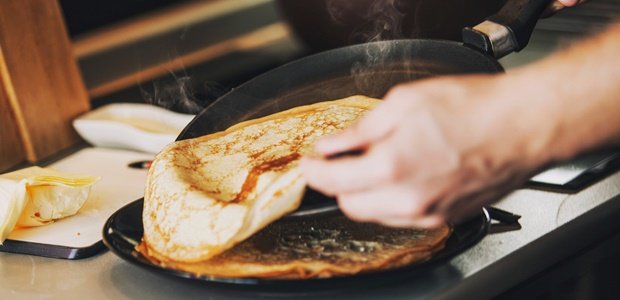(image: iStock)
Crêpes are one of those timelessly elegant French dishes. The classic Crêpe Suzette is always an on-trend (albeit retro), dessert option. Crêpes can be sweet or savoury and most recently there is the enormously popular crêpe cake trend.
Here is how to master the perfect crêpe:
How to say it
The first step to sounding like you know what you are talking about is the pronunciation of the word. In English, we say “krape” but if you want to sound like a true Frenchman, it is more like “krep” with a rolled R.
Thin, thin so very thin
A true crêpe is thin, so thin in fact, that you should be able to read the newspaper through it. Please don’t get a crêpe confused with an American pancake, or a crumpet, or even flapjack. The key to getting a thin crêpe is to have a runny batter. Don’t pour too much into your pan and let it spread as thinly as it can by tilting the pan. If you find your first one is too thick, add a little more milk to the batter to thin it until the perfect consistency has been achieved. You can even use soda water to make an even lighter batter.
Temperature of the pan
The temperature of the pan is key to getting a pale, lacy crêpe. The pan temperature should be quite low, allowing the crêpe to cook through before it browns, leaving just a light brown lacy pattern on the first side. Again, test your first one and adjust the temperature of your pan accordingly.
Type of pan
There are many special crêpe pans, but the most important attributes for a pan are a good non-stick pan that is still nice and flat (buckled pans lead to pooling of the batter making an uneven crêpe), and low sides of the pan allowing for easier turning of the crêpe. Eventually, even the most expansive non-stick pans end up having their “non-stick” loved off making it difficult to get the crêpe off the pan to turn it.
Fillings
Crêpes are so versatile you can eat them for breakfast, dinner or dessert. Pair them with fresh fruit, chocolate spread, lemon curd, clotted cream, chopped nuts or any other combination of toppings that take your fancy.
Savoury crêpes can have any variety of filling and do very well when baked almost like cannelloni. Old-school Crêpe Suzette is a classic served with flambéd Grand Marnier and a buttery, orangey, caramel sauce impressively lit tableside. But do mind your eyebrows.
Folding
Vary your presentation by folding the crêpes into quarters, or rolling them up. Make bite-sized pinwheels by slicing rolled stuffed crêpes.
Crêpe cakes
Trend alert! Crêpe cakes are taking the world by storm. Also called a mille crêpe (meaning a thousand crêpes) is about 15 crêpes layered together with delicious creamy fillings in between. Some of my favourites are crème brûlée, tiramisu or strawberry. Sometimes the final product is covered with icing or ganache. Yum!
A post shared by Trendy Bride Wedding Magazine (@trendybridemagazine) on
Follow the recipe below for perfect French Crêpes!
Ingredients:
250ml flour
Pinch salt
3 eggs
15ml sugar
500ml milk
15ml melted butter
Additional butter for frying
Method:
Sift the flour and salt together into a large bowl. Separately, whisk the eggs, sugar, milk and melted butter together. Add the liquid gradually, whisking all the time. Set the mixture aside to stand for a few hours, or overnight if possible. Strain the mixture through a sieve if needed. Lightly butter a non-stick pan, and heat on a low heat. Pour in a thin layer of batter. Cook until the top side has lost its shine, then carefully turn and cook on the other side. Crêpes should be thin, and not too brown. As you make them stack them on a plate and store until needed. Can be frozen for up to a month.
ALSO READ: How to make the perfect English scone
Save

